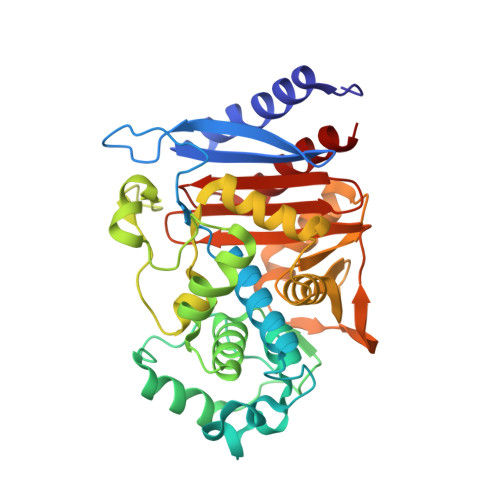FOX-4 cephamycinase: an analysis of structure and function.
Lefurgy, S.T., Malashkevich, V.N., Aguilan, J.T., Nieves, E., Mundorff, E.C., Biju, B., Noel, M.A., Toro, R., Baiwir, D., Papp-Wallace, K.M., Almo, S.C., Frere, J.M., Bou, G., Bonomo, R.A.(2015) Antimicrob Agents Chemother
- PubMed: 26525784
- DOI: https://doi.org/10.1128/AAC.01887-15
- Primary Citation of Related Structures:
5CGS, 5CGW, 5CGX - PubMed Abstract:
Class C β-lactamases poorly hydrolyze cephamycins (e.g., cefoxitin, cefotetan, and moxalactam). In the past 2 decades, a new family of plasmid-based AmpC β-lactamases conferring resistance to cefoxitin, the FOX family, has grown to include nine unique members descended from the Aeromonas caviae chromosomal AmpC. To understand the basis for the unique cephamycinase activity in the FOX family, we determined the first X-ray crystal structures of FOX-4, apo enzyme and the acyl-enzyme with its namesake compound, cefoxitin, using the Y150F deacylation-deficient variant. Notably, recombinant expression of N-terminally tagged FOX-4 also yielded an inactive adenylylated enzyme form not previously observed in β-lactamases. The posttranslational modification (PTM), which occurs on the active site Ser64, would not seem to provide a selective advantage, yet might present an opportunity for the design of novel antibacterial drugs. Substantial ligand-induced changes in the enzyme are seen in the acyl-enzyme complex, particularly the R2 loop and helix H10 (P289 to N297), with movement of F293 by 10.3 Å. Taken together, this study provides the first picture of this highly proficient class C cephamycinase, uncovers a novel PTM, and suggests a possible cephamycin resistance mechanism involving repositioning of the substrate due to the presence of S153P, N289P, and N346I substitutions in the ligand binding pocket.
- Department of Chemistry, Hofstra University, Hempstead, New York, USA.
Organizational Affiliation:



















